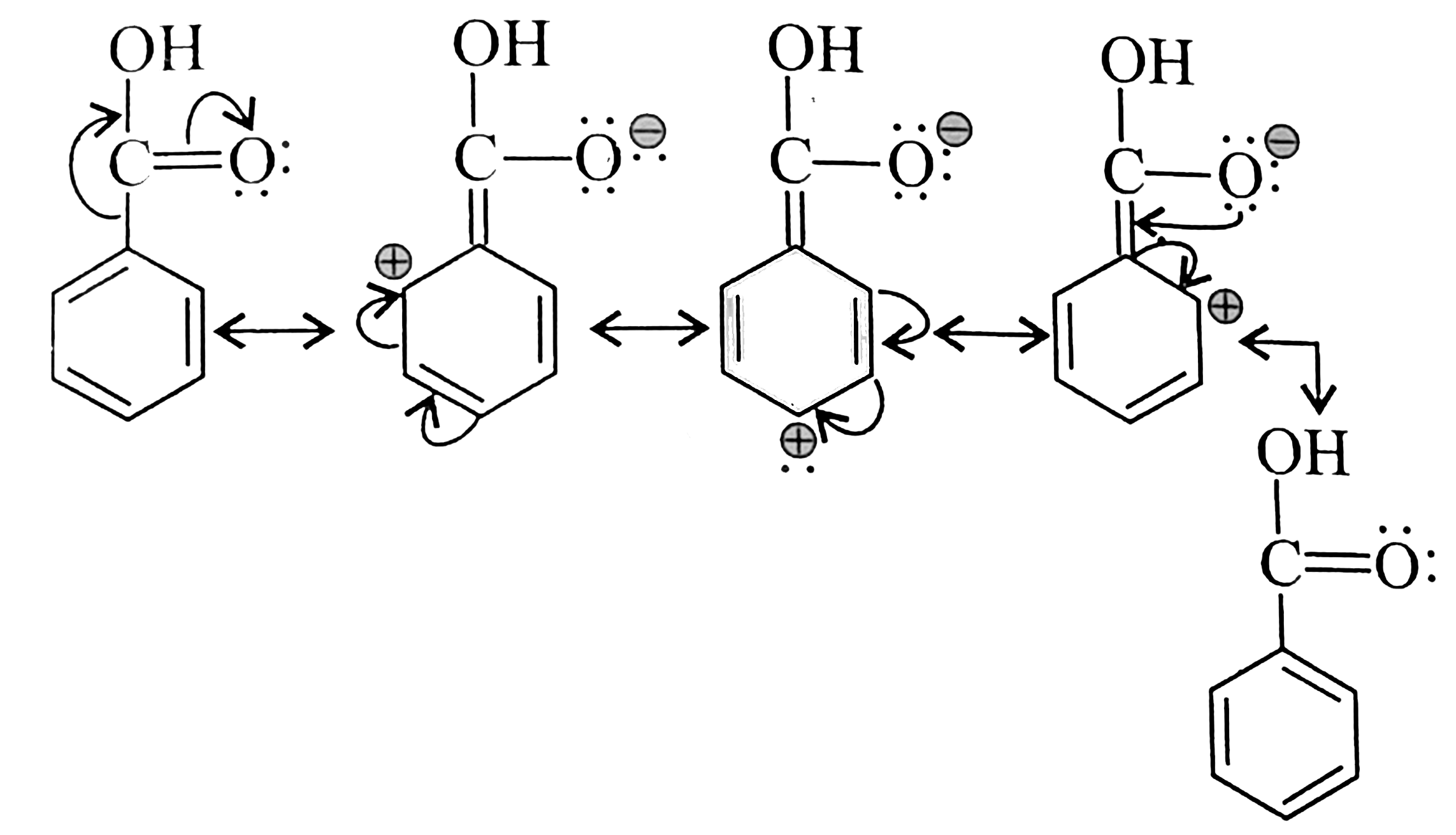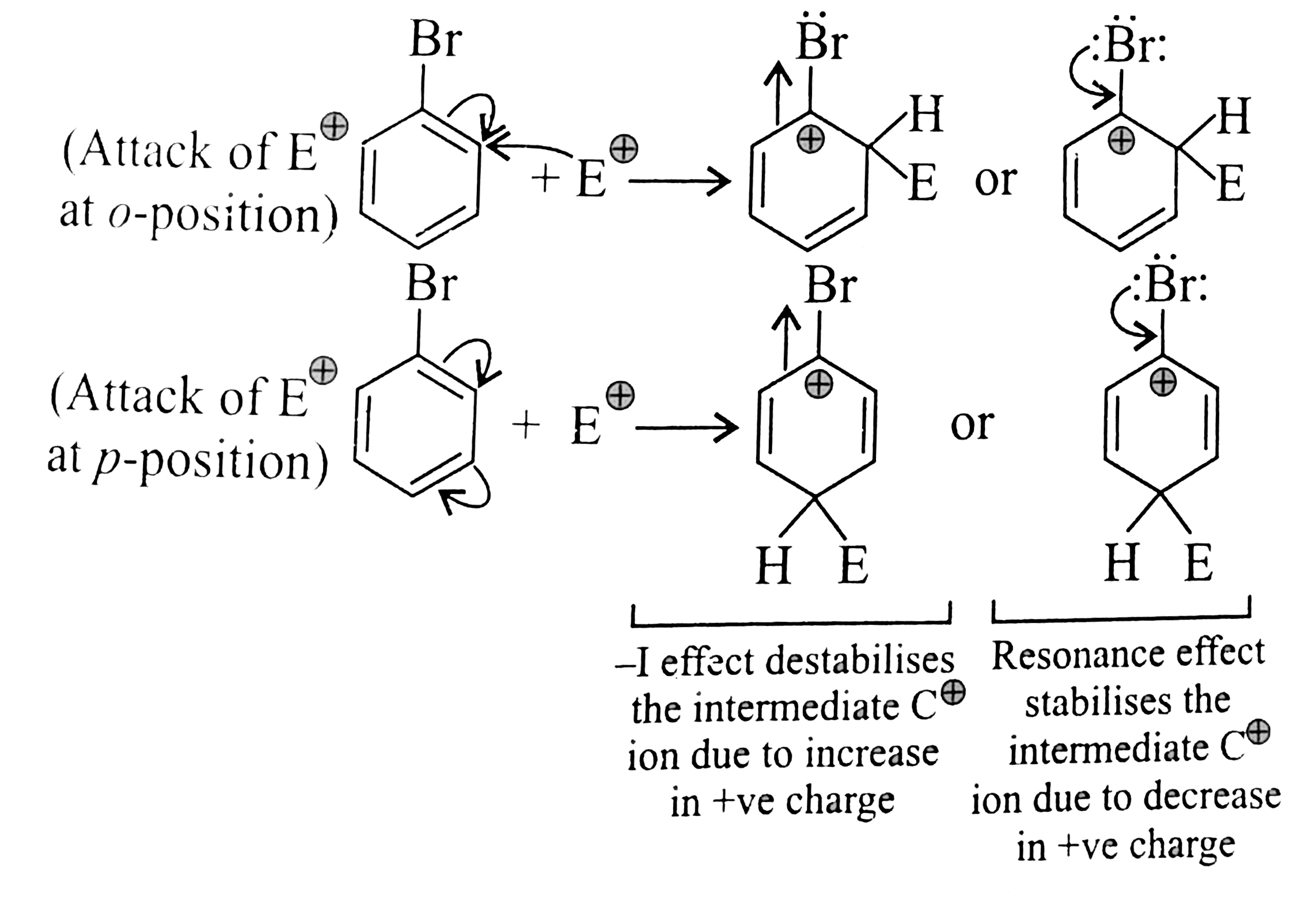a. Why are ¯e donating groups, such as (−NH2) (−OR), (−R)o− and p− directing towards SE reaction? Explain by an example.
b. Why are ¯e withdrawing groups, [such as (−NO2,(−SO3H),(−CN),(−COOH), etc].m− direection towards SE reaction? explain by example.
c. Although halogens are ¯e withdrawing yet they are o− and p− directing towards SE reaction. Why?
a. Due to +M effect (or ovel∈e(e) donating effect) of (−NH2) group, aniline is resonance stablised as shown:

Due to this, the ring is activated at o− and p− positions. Thus, ¯e density is increased at these positions. Hence, the incoming electrophile attacks at these positions giving o− and p− products. b. Due to ¯¯¯¯¯¯¯e− withdrawing effect of the (−COOH) group, benozoic acid is resonance stablised as shown:

due to this, the benzene ring is deactived at o− and p− positons, thus ¯e density is decreased at these positon. So, comparatively ¯e density at m− position is increased, and hence the incoming electrophile attacks at m-postion giving m− products,
C. Halogens are said to be π donating but σ with-drawing, i.e., they withdraw ¯es thorugh resonance. The intermediate carbocation formed during SE reaction is destablised by the −1 effect of the halogens.

Resonane stablises the intermediate carbocation and this effect is more prominent at o− and p− positons, −I effect is stronger (due to high EN of halogens ) than resonance and causes net ¯e withdrawal, and thus causing net deactivation. The resonance effect for the attack at o− and p− positons and hence makes the deactivation lesss for o− and p− subsitution.
Topper's Solved these Questions
- AROMATIC COMPOUNDS AND ALKYL AND ARYL HALIDES BOOK - CENGAGE CHEMISTRY ENGLISHCHAPTER - AROMATIC COMPOUNDS AND ALKYL AND ARYL HALIDES EXERCISE - Solved Examples
21 Videos
- AROMATIC COMPOUNDS AND ALKYL AND ARYL HALIDES BOOK - CENGAGE CHEMISTRY ENGLISHCHAPTER - AROMATIC COMPOUNDS AND ALKYL AND ARYL HALIDES EXERCISE - Solved Problems
37 Videos
- APPENDIX INORGANIC VOLUME 2BOOK - CENGAGE CHEMISTRY ENGLISHCHAPTER - APPENDIX INORGANIC VOLUME 2EXERCISE - Short Answer Type
179 Videos
- BIOMOLECULESBOOK - CENGAGE CHEMISTRY ENGLISHCHAPTER - BIOMOLECULESEXERCISE - Exercises Archives (Analytical And Descriptive)
8 Videos
Similar Questions
Althrough chlorine is an electron withdrawing group, yet it is ortho-para-directing in electrophilic aromatic substitution reactions. Explain why it is so ?
View SolutionThe typical reaction of benzene and other aromatic compounds are electrophilic substitution. Presence of electron donating group activates the ring towards electrophilic substitution, while presence of electron withdrawing group deactivates the ring towards electrophilic substituion but at the same time activates the ring towards nucleophilic subsituion. Some groups are predominantly meta-directing and all of these are deactivating. Except halogen, most of the o−andp−directing groups are activating groups.
Which of the following compound is not formed.
_E01_248_Q01.png)
X represents mixture of organic compounds. The mixture does not contain
View SolutionThe typical reaction of benzene and other aromatic compounds are electrophilic substitution. Presence of electron donating group activates the ring towards electrophilic substitution, while presence of electron withdrawing group deactivates the ring towards electrophilic substituion but at the same time activates the ring towards nucleophilic subsituion. Some groups are predominantly meta-directing and all of these are deactivating. Except halogen, most of the o−andp−directing groups are activating groups.
_E01_246_Q01.png) C2H5Cl.AlCl3−−−−−−−−→Δ(A) major.
C2H5Cl.AlCl3−−−−−−−−→Δ(A) major.
A is trisubstituted benzene. The structure of A is :
View SolutionThe typical reaction of benzene and other aromatic compounds are electrophilic substitution. Presence of electron donating group activates the ring towards electrophilic substitution, while presence of electron withdrawing group deactivates the ring towards electrophilic substituion but at the same time activates the ring towards nucleophilic subsituion. Some groups are predominantly meta-directing and all of these are deactivating. Except halogen, most of the o−andp−directing groups are activating groups.
_E01_246_Q01.png) C2H5Cl.AlCl3−−−−−−−−→Δ(A) major.
C2H5Cl.AlCl3−−−−−−−−→Δ(A) major.
A is trisubstituted benzene. The structure of A is :
View SolutionAssertion (A) : Gabriel phthalimide reaction is used for the prepartion fo C2H5NH2 and p-nitro aniline .
Reason (R ): SN2 reaction takes place with 1∘RX and 1∘ArX containing ¯e- withdrawing group at o-and p-positions
View SolutionWhy are (o+p) in ratious for the SE reaction (e.g. nitraction) of toluene and PhCF,32.3 and 0.14, respectively ?
View Solution(a) Explain why H2andO2 do not react at room temperature.
(b) Writen the rate equation for the reaction
A2+3B2→2C, if the overall order of the reaction is zero.
View SolutionConcrete is produced form a mixture of cement, water and small stones. Small amount of gypsum, CaSO4.2H2O is added in coment production to impove the subsequent hardening of concrete. The elevated temperature during the production of cement may lead to the formation of unwanted hemihydrate CaSO412H2O according to reaction.
CaSO42H2O(s)→CaSO412H2O(s)+32H2O(g)
The ΔfHΘofCaSO2.2H2O(s),CaSO412H2O(s),H2O(g)
are −2021.0kJmol−1,−1575.0kJmol−1 and −241.8kJmol−1, respectively. The respective values of their standard entropies are 194.0,130.0 and 188.0JK−1mol−1. The values of R=8.314JK−1mol−1=0.0831L bar mol−1K−1.
Answer the following questions on the basis of above information.
The equilibrium pressure of water vapour in closed vessel containing CaSO42H2O(s),CaSO412H2O(s) and H2O(g) at 298K (Antilog −3.14=7.24×10−4) is
View SolutionRedox reactions play a pivotal role in chemistry and biology. The values standard redox potential (Eo) of two half cell reactions decided which way the reaction is expected to preceed. A simple example is a Daniell cell in which zinc goes into solution and copper sets deposited. Given below are a set of half cell reactions ( acidic medium ) along with their Ec−(V with respect to normal hydrogen electrode ) values. Using this data, obtain correct explanations for Question.
I2+2e−→2Ic−, Ec−=0.54
Cl2+2e−→2Clc−, Ec−=1.36
Mn3++e−→Mn2+, Ec−=1.50
Fe3++e−→Fe2+, Ec−=0.77
O2+4H⊕+4e−→2H2O, Ec−=1.23
Sodium fusion extract obtained from aniline on treatment with iron (II) sulphate and H2SO4 in the presence of air gives a Prussion blue precipitate. The blue colour is due to the formation of
View SolutionRedox reactions play a pivotal role in chemistry and biology. The values standard redox potential (Ec−) of two half cell reactions decided which way the reaction is expected to preceed. A simple example is a Daniell cell in which zinc goes into solution and copper sets deposited. Given below are a set of half cell reactions ( acidic medium ) along with their Ec−(V with respect to normal hydrogen electrode ) values. Using this data, obtain correct explanations for Question.
I2+2e−→2Ic−, Ec−=0.54
Cl2+2e−→2Clc−, Ec−=1.36
Mn3++e−→Mn2+, Ec−=1.50
Fe3++e−→Fe2+, Ec−=0.77
O2+4H⊕+4e−→2H2O, Ec−=1.23
Among the following, identify the correct statement.
(a)Chloride ion is oxidized by O2.
(b)Fe2+ is oxidized by iodine.
(c)Iodide ion is oxidized by chlorine
(d)Mn2+ is oxidized by chlorine.
View Solution
